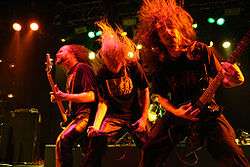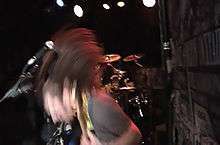Headbanging
Headbanging is violently shaking one's head in time with music. It is common in the contemporary rock, punk and heavy metal music genres, where headbanging is often used by musicians on stage. In recent times, headbanging has become more common in various electronic dance music genres.[1] Headbanging is also common in traditional Islamic Sufi music traditions such as Qawwali in the Indian subcontinent and Iran.

History
Sufi music
Headbanging has been common in Islamic devotional Sufi music traditions dating back centuries, such as the Indian subcontinent's 600-year-old Qawwali tradition,[2][3] and among dervishes in Iran's Kurdistan Province.[4] Qawwali performances, particularly at Sufi shrines in the Indian subcontinent, usually in honour of Allah, Islamic prophets, or Sufi saints, often have performers and spectators induced into a trance-like state and headbanging in a manner similar to metal and rock concerts.[5][6][7] A popular song often performed by Sufis and fakirs in the Indian subcontinent is the 600-year-old "Dama Dam Mast Qalandar" (in honour of 13th-century Sufi saint Lal Shahbaz Qalandar), which often has performers and spectators rapidly headbanging to the beats of naukat drum sounds.[3]
The most well-known Qawwali performer in modern times is late Pakistani singer Nusrat Fateh Ali Khan, whose performances often induced trance-like headbanging experiences in the late 20th century.[2] Khan's popularity in the Indian subcontinent led to the emergence of fusion genres such as Sufi rock and techno qawwali in South Asian popular music (Pakistani pop, Indi-pop, Bollywood music and British-Asian music) in the 1990s which combine the traditional trance-like zikr headbanging of Qawwali with elements of modern rock, techno or dance music, which has occasionally been met with criticism and controversy from traditional Sufi and Qawwali circles.[8]
Rock music
The origin of the term "headbanging" is contested. It is possible that the term "headbanger" was coined during Led Zeppelin's first US tour in 1969.[9] During a show at the Boston Tea Party concert venue, audience members in the first row were banging their heads against the stage in rhythm with the music.
Furthermore, concert footage of Led Zeppelin performing at the Royal Albert Hall January 9, 1970, on the Led Zeppelin DVD released in 2003, the front row can be seen headbanging throughout the performance.[10]
Ozzy Osbourne and Geezer Butler of Black Sabbath are among the first documented headbangers, as it is possible to see in footage of their gig in Paris, 1970.[11]
Lemmy from Motörhead, however, said in an interview on the documentary The Decline of Western Civilization II: The Metal Years, that the term "Headbanger" may have originated in the band's name, as in "Motorheadbanger".
Ian Gillan, frontman of Deep Purple, when asked if he invented headbanging, said: "That’s a definite possibility", although he claimed that "it was not really head banging — more hair floating".[12]
The practice itself and its association with the rock genre was popularized by guitarist Angus Young of the band AC/DC.[13]
Early televised performances in the 1950s of Jerry Lee Lewis depict young male fans who had grown their hair in the fashion of Lewis, where his front locks would fall in front of his face. Lewis would continuously flip his hair back away from his face, prompting the fans to mimic the movement in rapid repetition in a fashion resembling Head banging.

Health issues
In 2005, Evanescence guitarist Terry Balsamo incurred a stroke which doctors postulated may have been caused by frequent headbanging.[16] In 2007, Irish singer and former Moloko vocalist Roisin Murphy suffered an eye injury during a performance of her song "Primitive" when she headbanged into a chair on stage.[17] In 2009, Slayer bassist/vocalist Tom Araya began experiencing spinal problems due to his aggressive form of headbanging, and had to undergo anterior cervical discectomy and fusion. After recuperating from the surgery, he permanently can no longer headbang.[18][19] In 2011, Megadeth guitarist Dave Mustaine said that his neck and spine condition, known as spinal stenosis, was caused by many years of headbanging.[20] Slipknot sampler Craig Jones once suffered from whiplash after an extended case of powerful headbanging.
Several case reports can be found in the medical literature which connect excessive headbanging to aneurysms and hematomas within the brain and damage to the arteries in the neck which supply the brain. More specifically, cases with damage to the basilar artery,[21][22] the carotid artery[23] and the vertebral artery[24] have been reported. Several case reports also associated headbanging with subdural hematoma,[25][26] sometimes fatal,[27] and mediastinal emphysema similar to shaken baby syndrome.[28] An observational study comparing headbanging to non-headbanging teenagers in a dance marathon concluded that the activity is associated with pain in varying parts of the body, most notably the neck, where it manifests as whiplash.[29]
See also
| Wikimedia Commons has media related to Headbanging. |
References
- Vogelsanger, Sara. "The History of Headbanging". relentlessbeats. relentlessbeats. Retrieved 10 March 2017.
- Gehr, Richard (October 1991). "World Beat: Nusrat Fateh Ali Khan". Spin. SPIN Media LLC. 7 (7): 100.
- "Lal meri pat: This is how the Red Sain puts the djinn and Sehwan in a trance". The Express Tribune. 19 October 2011.
- "The Headbanging Dervishes of Eastern Kurdistan". CVLT Nation. 19 January 2018.
- Singh, Bismark (August 2018). "An Evaluation of Religious Unity in the Indian Context: Based on Indian Sufi Shrines". ResearchGate.
- Bukhari, Kyle (2014). "Restraint and Transgression: Ecstatic Movement and Profane Lyricism in the Sufi Qawwali at Urs Ajmer Sharif". Academia.edu.
- Rockwell, John (5 March 1975). "Qawwali Music Stirs Audience". The New York Times.
- Salhi, Kamal (2013). Music, Culture and Identity in the Muslim World: Performance, Politics and Piety. Routledge. p. 194. ISBN 9781317963103.
- Lewis, Dave; Pallett, Simon (2005). Led Zeppelin: Concert File. Omnibus Press. ISBN 978-1-84449-659-4.
- "Led Zeppelin - Communication Breakdown - Royal Albert Hall 1970". YouTube. 15 October 2007. Retrieved 23 February 2015.
- "Black Sabbath Paris 1970 Live Full Concert". YouTube. 10 August 2013. Retrieved 23 February 2015.
- Ian Gillan & Ian Paice Interview with Simon Copeland from The Sun, March 2007 deep-purple.net. 2007. Retrieved on 2009-09-03.
- "Yahoo". Archived from the original on 28 July 2014. Retrieved 23 February 2015.
- https://www.npr.org/2019/07/09/739523240/snowball-the-dancing-cockatoo-vogues-and-body-rolls-on-beat
- https://www.theatlantic.com/science/archive/2019/07/what-snowball-dancing-parrot-tells-us-about-dance/593428/
- Evanescence Guitarist: Filling Ben Moody's Shoes | Interviews @ Ultimate-Guitar.Com Archived 2006-11-16 at the Wayback Machine
- Roisin Murphy’s Head-Banging-Accident Archived 2014-09-03 at the Wayback Machine iheartberlin.de. 30 October 2007. Retrieved on 24 August 2012.
- Slayer Frontman Tom Araya To Undergo Back Surgery, American Carnage Tour To Be Rescheduled metealunderground.com. 7 January 2010. Retrieved on 4 August 2012.
- "No more headbanging for mortal Slayer frontman". The San Francisco Examiner. Archived from the original on 27 May 2013. Retrieved 23 February 2015.
- "Ouch! Headbanging Hurts…". cbslocal.com. Archived from the original on 23 February 2015. Retrieved 23 February 2015.
- Edvardsson, Bengt (7 Jul 2011). "Head banging associated with basilar artery thrombosis". Neurology India. 59 (3): 478–9. doi:10.4103/0028-3886.82756. PMID 21743194.
- Rajasekharan, Chandrasekharan (2013). "Basilar artery thrombosis due to head banging: hazard of a religious ritual". BMJ Case Reports. 2013: bcr2013009840. doi:10.1136/bcr-2013-009840. PMC 3669841. PMID 23704461. Retrieved 28 Aug 2014.
- Jackson, M.A. (1983). ""Headbanging" and carotid dissection". British Medical Journal (Clinical Research Ed.). 287 (6401): 1262. doi:10.1136/bmj.287.6401.1262. PMC 1549725. PMID 6416361.
- Egnor, M.R. (1991/1992). (1991). "Vertebral Artery Aneurysm – A Unique Hazard of Head Banging by Heavy Metal Rockers". Pediatric Neurosurgery. 17 (3): 135–138. doi:10.1159/000120583. PMID 1819327.
- Neyaz, Z. (2006). "'Head banging' during rock show causing subdural hematoma". Neurology India. 54 (3): 319–20. doi:10.4103/0028-3886.27172. PMID 16936407. Retrieved 28 Aug 2014.
- Islamian, Ariyan Pirayesh (5 Jul 2014). "Chronic subdural haematoma secondary to headbanging". The Lancet. 384 (9937): 102. doi:10.1016/S0140-6736(14)60923-5. PMID 24998813. Retrieved 28 Aug 2014.
- Mackenzie, J.M. (7 Dec 1991). ""Headbanging" and fatal subdural haemorrhage". The Lancet. 338 (8780): 1457–1458. doi:10.1016/0140-6736(91)92757-S. PMID 1683440.
- Matsuzaki, Saeko (Dec 2012). "Mediastinal Emphysema After Head-Banging in a Rock Artist: Pseudo Shaken-Baby Syndrome in Adulthood". The Annals of Thoracic Surgery. 94 (6): 2113–2114. doi:10.1016/j.athoracsur.2012.05.054. PMID 23176926. Retrieved 28 Aug 2014.
- Kassirer, Marilyn (Jun 1993). "Head Banger's Whiplash". The Clinical Journal of Pain. Retrieved 28 Aug 2014.